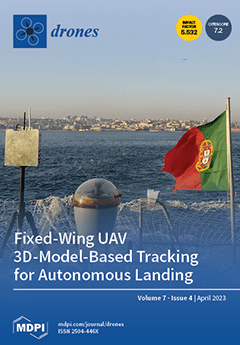This study proposed a novel nonlinear blended aerodynamic model for the tiltrotor unmanned aerial vehicle (UAV) during the transition phase to handle the high angle-of-attack (AoA) flight, which aggregated the flat-plate mode and the linear mode of the aerodynamic coefficients. Additionally, a harmonic
[...] Read more.
This study proposed a novel nonlinear blended aerodynamic model for the tiltrotor unmanned aerial vehicle (UAV) during the transition phase to handle the high angle-of-attack (AoA) flight, which aggregated the flat-plate mode and the linear mode of the aerodynamic coefficients. Additionally, a harmonic disturbance observer (HDO) and super-twisting sliding mode controller (STSMC) addressed the fast-changing external disturbances and attenuated the chattering problem in the original SMC. The comparative trajectory tracking results indicated that the blended aerodynamic model accurately tracks the reference signals with no tracking errors, which demonstrated a superior performance as compared to the traditional aerodynamic model, with a reduction of 2.2%, 50%, 73.6%, and 11.2% in the time required for tracking the pitch angle, pitch rate, and velocities
u and
w, respectively. Conversely, the traditional one exhibited significant tracking errors, ranging from 0.016° in the pitch angle channel to 1.25°/s in the pitch rate channel, and 0.6 m/s for velocity
u and 0.01 m/s for velocity
w. Moreover, the comparative control input results illustrated that the least control effort was required for the proposed HDO-STSMC control scheme with a blending function, while the original ESO-SMC experienced more oscillations and sharp amplitude changes, taking twice the time to converge, with considerable tracking errors such as 1.067° in the pitch angle channel, 0.788°/s in the pitch rate channel, 1.554 m/s for velocity
u, and 0.746 m/s for velocity
w, which verified the feasibility and superiority of the proposed HDO-STSMC with the blending function. Two performance indices revealed the robust stability and rapid convergence of the proposed transition blended aerodynamic model with the HDO-STSMC control scheme.
Full article





